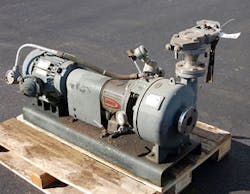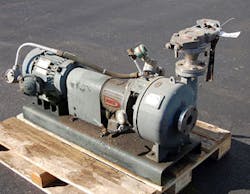Preventing Pump Deterioration
Pumps are an essential tool for the industry, providing the necessary pressure to shift water for distribution and processing. This article looks at how deterioration and wear develops and affects the performance of water pumps. Advice is provided on water pump specification, the water pump condition monitoring practice and the water pump renovation methods.
By Amin Almasi
Any water pump exhibits the effects of wear and tear over time. The function of a water pump is the result of the fine-tuned cooperation of many different components. The emphasis of the deterioration and wear study should be on the entire water pump train as a system rather than on isolated components.
Several mechanisms can cause the deterioration and wear of a water pump. The "Fouling" is caused by the adherence of particles to the water pump flow path surfaces. The "Corrosion" is the loss or the deterioration of the component material exposed to the water (caused by the chemical reactions). The "Erosion" is the abrasive removal of material from the flow path by hard particles impinging on the pump flow surfaces. The "Abrasion" is caused when a rotating surface rubs on a stationary surface. Foreign objects can also cause some damages to the pump components.
Deterioration and Wear
Three major effects determine the performance deterioration of water pumps:
- The increased clearances
- The changes in the rotating/static part geometry
- The changes in the water flow path surface quality.
The stage deterioration (and wear) has a cumulative effect. A degraded stage will create different exit conditions compared to a new stage, and each subsequent stage will operate further away from its design point. While in a new water pump all stages and components were working at their optimum efficiency point, the deterioration (and wear) will force all stages to work at off-optimum efficiencies.
The deterioration/wear can also limit the water pump operating range. Typically, a degraded water pump will have reduced margins (such as NPSH (Net Positive Suction Head) margins, and others). The pressure ratio and the flow are not independent, and the efficiency is determined by the resulting operating point. The centrifugal water pump deterioration will shift the pressure-flow relationship to a lower efficiency. In a comprehensive study, the deterioration/wear effects which normally occur together should be separated. The deterioration/wear will impact the pressure ratio, the efficiency, and the water flow capacity (the degree depending on the type of the deterioration).
Since in many instances, the operating point on a water pump map is different between the new water pump and the degraded water pump, the actual efficiency can be affected by the deterioration/wear (and the move of the operating point). Maintaining of the water pump component clearances is, in particular, a problem in some water pumps. This is because of various dynamic loadings and changes in the temperature (between the ambient temperature and the operating temperature).
Studies have shown the increase in clearances can affect the water pump performance. In a study on a water pump, the clearance was increased from 2.5% (the design value) to 4.6% and this led to approximately 7% reduction in the pressure coefficient, and an around 2.3% efficiency loss.
The "Corrosion" tends to alter the water flow path in two ways; it increases the surface roughness, but it might also remove the materials from the critical water pump components.
Increased surface roughness can cause thicker boundary layers on the both the moving components (such as impellers) and the stationary components (such as the parts of the water pump casing in contact with the water), and thus reduce the flow capacity. Furthermore, changes in the flow capacity of a water pump can subsequently alter the operating point.
When the deterioration/wear of a water pump led to the material removal (for example, at a pump impeller), complex effects and interactions might be seen. The flow capacity can also be limited. The flow angles could also be deviated with some important efficiency and pressure effects. The erosion can cause flow angles to deviate (for example, flow angles in impellers).
This will lead to a reduced efficiency. Deposits on the water path both can increase the flow path surface roughness and might (if thick enough) decrease the flow area of the water pump.
Solid particles which travel through the water flow path can be subjected to dynamic forces. The pumped water carries these particles though the pump where they may impact on the pump parts and cause the solid particle erosion. As these particles lose momentum they move outward toward the tips of the rotating parts (such as impellers) and can cause erosion or lodge underneath some parts.
Electric motor
The electric motor deterioration and wear might be identified as the rotor assembly problems, the misalignment, the unbalance, the eccentricity and the stator mechanical/electrical faults. Too often, the bearings of an electric motor can be a source of trouble. The electrical hardware of the electric motors (such as the coil, the winding, other), if properly sized and manufactured, will last for a long-time.
Insulations may degrade in a relatively shorter time. Latest techniques such as the ultra-wide band partial discharge techniques can be employed to identify the insulation deterioration/wear. Generally, the electrical system deterioration and wear can be evaluated by measuring the voltage imbalance, the high harmonic content of currents and voltages, and other electrical parameters.
Efficiency/flow reduction
The efficiency losses of around 2-6% have been reported for some surface roughness built-up when compared with smooth surface of new water pump components. It was also reported that the most pronounced differences appear at the optimum operating point (the BEP (Best Efficiency Point) of a water pump), whereas the far off-optimum efficiency is less affected.The surface roughness losses could be in the same order of magnitude as losses because of clearance changes. The reduction in the water pump efficiency as the result of the pump deterioration and wear was observed in many studies.
In several cases of VSD (variable frequency drive) driven water pumps, the pressure-flow relationship of the pump operating points remain unchanged.
This is because it is determined by the pump control system, but the pumps have to run faster, and consume more power for any point on the pressure-flow curve once deteriorated.
In the multi-stage water pumps, more deposits could occur on the first stages rather than the last stages. The deterioration has usually shifted the pump operating line to a lower flow-rate, a lower pressure ratio and a lower efficiency.
Different studies have shown further that the deterioration/wear not only leads to reduced stage performance, but also to additional losses because individual stages no longer operate at their design (or rated) flow coefficients.
Severe deteriorations of a water pump and significant reductions in the water pump efficiency can occur when the material is removed because of the "erosion" or the "corrosion".
Usually at a constant load (a constant shaft power), a considerable drop in the water pump efficiency can cause a reduction in the flow and the discharge pressure.
The operating points of a deteriorated water pump were consistently at lower flow coefficients compared to a new water pump. The flow capacity reduction has mainly been the result of the "fouling" or the "increased clearances".
Water pumps at part-load
It was observed that smaller water pumps may be more susceptible to the deterioration and wear. However, there has been no universal agreement on this issue and some previous reports reached exactly the opposite conclusion.
It is suspected that the intricate interactions that define the amount of deterioration/wear as a function of a certain level of ingested material or of a certain amount of material removal, are very machine specific and do not lend themselves to simplified rules of thumb.
A relative loss in the pump efficiency can be lower compared to the full-load/rated-load (the same amount of the deterioration/wear). The flow and the discharge pressure usually change relatively lower at the part-load as the result of the deterioration/wear.
A proper water pump design/selection and the selection of the inlet filtration, together with the proper maintenance and operating practices, can significantly affect the level of performance deterioration/wear and thus time between repairs or overhauls of a water pump.
Amin Almasi is a lead rotating equipment engineer at WorleyParsons Services. For more information, email: [email protected]

